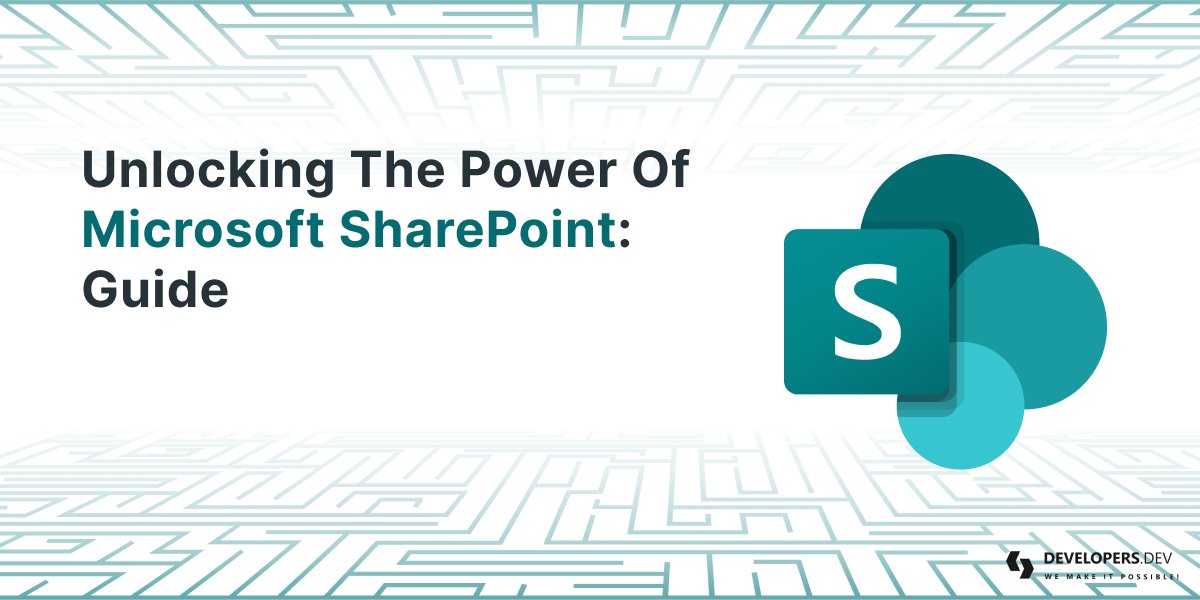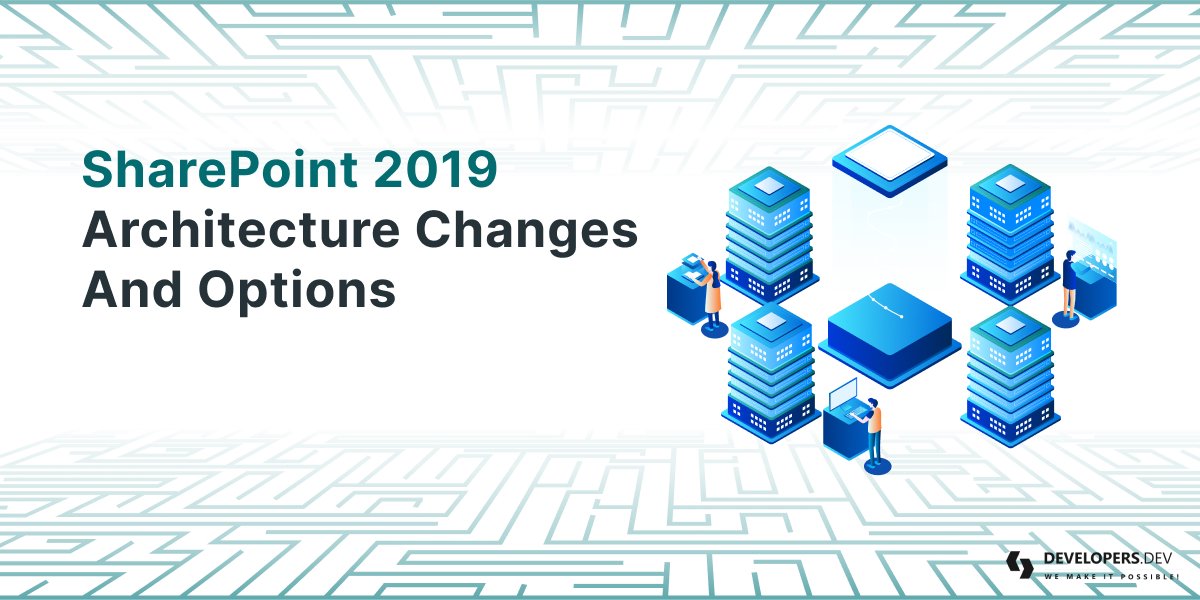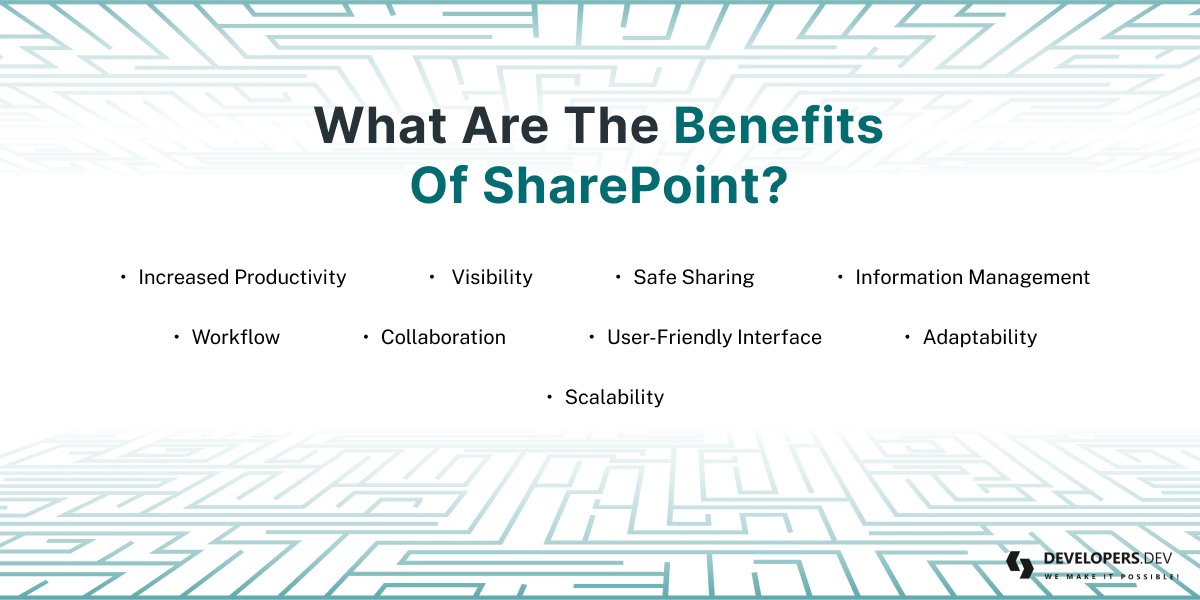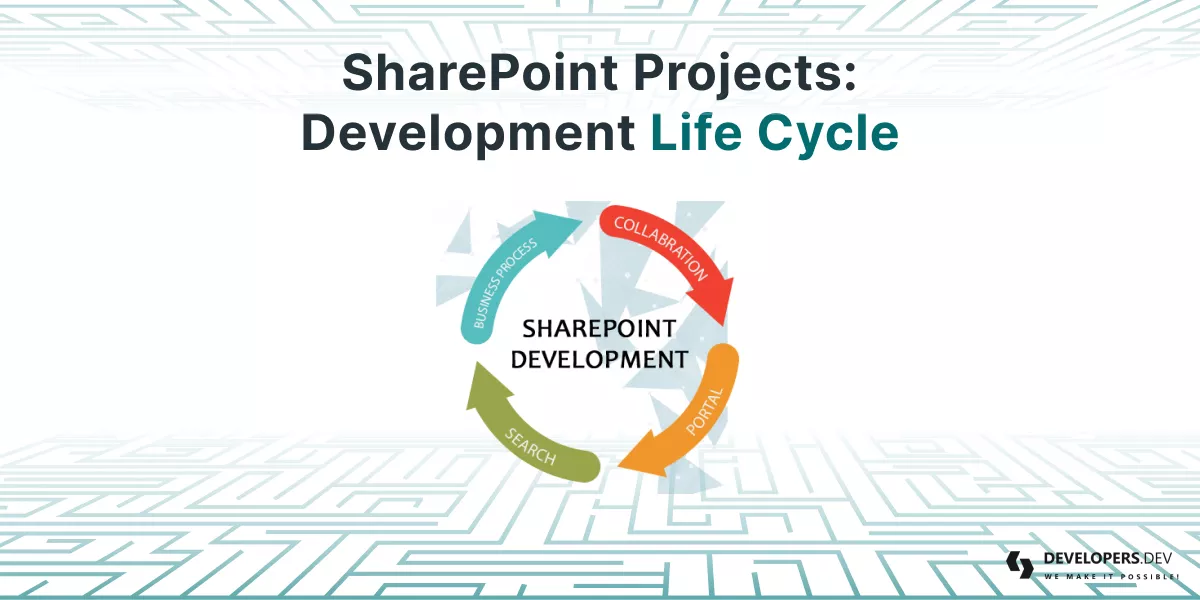
To fully leverage Microsoft SharePoint, enterprises must understand its capabilities beyond simple document and content management.
SharePoint provides comprehensive enterprise content management tools that are available via web browsers, such as document organization, site management, analytics, and workflows. SharePoint Online, a component of Microsoft 365, improves cloud integration and collaboration with new apps and services.
Recent SharePoint versions include additional features such as business intelligence, compliance tools, improved accessibility, and connection with Office 365 apps. Using SharePoint's customisation options, hybrid capabilities, and advanced workflows can greatly improve productivity and cooperation within businesses.
As a SharePoint developers firm, We have seen SharePoint as a tool at both ends of the spectrum.
Many businesses use SharePoint in this way, whether for content management or document management. You might not be utilizing SharePoint to its full potential because it can be utilized independently.
This blog will answer many questions about SharePoint usage that should be addressed more. Over 200 million users rely on SharePoint as Microsoft is again recognized as a Leader in the 2020 Gartner Content Services Platforms Magic Quadrant Report.
Our goal is to help you set up SharePoint so that it provides the best value.
What Is Microsoft SharePoint?
Microsoft SharePoint is a document management and enterprise collaboration tool that allows businesses to handle shared documents, reports, archives, and other types of content crucial to their operational procedures.
Enterprise content management features of SharePoint can be utilized by businesses in all sectors and across all divisions.
A web browser can be used to configure SharePoint. Most of SharePoints features are delivered via a web user interface and online applications.
You can edit content and structure in a sharepoint site, add or remove sites, turn off product features, handle analytics, and set up simple sharepoint workflows.
What Is SharePoint Online?
The Microsoft Cloud version of SharePoint, called SharePoint Online, provides a wide range of cloud application integration options.
Many additional Microsoft products with an Office 365 group, Microsoft 365 apps, or Microsoft 365 license can be used with it.
SharePoint Features Updated And New
The most recent version of the programme is SharePoint 2019. The Office 365 package includes SharePoint. It also goes by the name SharePoint Online.
Microsoft corporation also provides an online version of SharePoint for businesses that need to keep their data secure or compliant.
SharePoint has the following notable features:
- In SharePoint 2019, business intelligence (BI) is accessible.
Access to BI connects with Microsoft Power BI.
- Compliance. A company's central admin can build and apply policies using SharePoints In-Place Hold Policy Center and Compliance Policy Center. Users of OneDrive for Business can remove files.
- Accessibility to the document library. SharePoint provides accessibility for the document collection, page landmarks to make navigating pages simple, keyboard shortcuts for various operations, notifications on upload status, and better callout readings.
- Expanded file name extensions. File names with more than 128 characters and special characters (beginning with dots) are supported.
- Folder sharing. You can invite others, view who has shared a folder and accept or reject access requests.
- Integration with Office 365 tools, services and programs such as Microsoft Sway is improved.
- Information rights management is Digital Rights Management capabilities that protect intellectual property and sensitive information from unauthorized access.
- Support for large files. The size of files is unrestricted. Microsoft advises against storing files larger than 10GB. The maximum file size for uploads is 250 GB.
- MinRole is Administrators can install only those roles on SharePoint servers.
- Mobile environment. The new interface provides a contemporary experience and is touch-friendly. Switching between the PC and mobile views is simple.
- To enhance site navigation, SharePoint offers mega menus that may be displayed on mobile and desktop versions of the platform. SharePoint gives programmers the ability to make page shortcuts.
- Server for project management. Project managers might request resources and use a heatmap function to find out where resources are spending their time. Additionally, they can create several timelines. Better backup and restoration capabilities are now available on Project Server.
- Project Syntax is To help staff members locate essential metadata in emails and presentations, SharePoint is integrated with Microsoft intelligent search. Syntex uses machine learning and artificial intelligence to automate turning content into a knowledge base.
- Security is Co-authoring, autosaving for encrypted documents, information bars, and automatic expiration are all features of Microsoft SharePoint 2019.
- Pin site pages. When users are online or using Office 365, they can pin websites to be followed.
- Thanks to these locations, teams may work together on projects and communicate information anywhere. A microsoft team site is a grouping of associated websites. It also has customizable web components, data management lists, and a preset document library.
- Yammer is the social networking site Yammer offers social feeds that may be customized so that staff members can engage with the SharePoint environment.
Microsoft SharePoint Features That Are No Longer Supported
Traditional document management was supported in the design of SharePoint 2016. Traditional document management was the primary emphasis of the creation of SharePoint 2019.
These tasks consist of the following:
- Delve: Data discovery and visualization software that incorporates social networks, machine learning, and Office 365 search features.
- Office Graph: The Office 365 Suites back-end utility makes it easier to search across connected applications. It uses machine learning in interactions within organizations.
- Sway: An Office presentation tool.
- Teams are a tool for online collaboration that enables managers and staff members from different locations to work together on a document.
- Yammer: A platform for private collaboration and microblogging to advance business social networking.
SharePoint Online will be the primary target of Microsoft's development efforts. Because certain customers cannot transition to the cloud due to compliance concerns, Microsoft will continue to offer versions for on-premises systems.
The following features were also removed from SharePoint 2016 server:
- Excel Solutions: SharePoint Server no longer houses Excel features.It is now a component of Office Online Servers Excel Online.
- Forefront Identity Manager: Active Directory and SharePoint are synced through FIM.Instead of using FIM, SharePoint 2016 uses Microsoft Identity Manager 2016 (or another third-party product).
- SharePoint BI capabilities: Power Pivot or Power View for Business BI are not supported by SharePoint 2016. If you are using SQL Server 2016, you cannot deploy the Power Pivot and Power View for SharePoint add-ins in SharePoint 2016.
- SharePoint Foundation: A free edition of SharePoint Foundation offers a safe web-based collaboration platform. It is not supported by SharePoint Server 2016, but it is still supported by SharePoint 2013.
- Standalone Installation Mode: This function is no longer available in SharePoint 2016.With MinRole farm topology in its place.
- Notes And Tags: Microsoft discourages the usage of this feature because it is planned to be withdrawn, even though sharepoint users can still add tags and browse current tags.
- Work Management Service Application: The accompanying Exchange Task Sync functionality, My Tasks, and this application were all withdrawn.
The following functionality has been eliminated or deprecated in SharePoint Server 2019:
- Access Services 2010 And 2013: Will be discontinued, but they will still be supported.Microsoft recommends that you explore Microsoft PowerApps or Power Automate.
- Aggregated News Feed: In SharePoint 2019, this news feed has a read-only status.For Teams News, Microsoft suggests Yammer, Communication Sites, and Teams.
- Custom Assistance: Microsoft no longer uses its old assistance engine and has switched to a cloud-based customer service platform that works with Office 365.
- Machine Translation Service: The support for this feature has ended.Utilizing multilingual communication platforms is encouraged for users.
- Multi-Tenancy: Due to the growing complexity of multi-tenancy SharePoint on-premises setups, Microsoft discontinued this function.
- PDF Reader: Since most web browsers already have built-in PDF reading capabilities, the integrated PDF reader capability has been deleted.
- Site Mail: Will be discontinued but still supported. Customers are advised to use the shared mailboxes option by Microsoft.
SharePoint 2019 Architecture Changes And Options

As part of Microsoft's goal to make SharePoint a cloud-first solution, SharePoint 2019 includes architectural deployment patterns first offered in SharePoint 2016.
Microsoft stated that SharePoint 2019 would improve many cloud-first technologies it introduced in 2016.
Service deployments were necessary to maintain problematic servers in SharePoint 2013 and older versions. SharePoint 2016 has a reduced structure called MinRole.
It has a server that manages certain services according to their function. It has not turned on any more services.
This makes it possible for each server to receive quick updates and additional flexibility, and simple fixes.
Faster and better service are the results. The MinRole farm structure is used by SharePoint Online and SharePoint Server 2019.
The architectural deployment model of SharePoint has mostly stayed the same since it was first released in 2016.
There will be four architectural models in SharePoint 2019.
Mobile And Desktop Experiences Streamlined
Even though it might seem obvious, mobile workers are more crucial than ever-a trend that has been accelerating in recent years.
Thanks to enhancements to the SharePoint mobile app, users may connect with the intranet and access it more quickly with SharePoint Server 2019.
Users of OneDrive for Business may now access documents from any location and device, thanks to an updated sync client.
This enables businesses to sync files from Office 365 or SharePoint to a laptop located on-site. This improves collaboration for mobile and office workers.
Increased Customization Opportunities
SharePoint Server 2019 has us the most enthusiastic, and we anticipate that most customers will feel the same way.
2019s SharePoint Server provides more customization options. This new platform interfaces with PowerApps/Flow so that you can add new solutions to your environment or design bespoke processes.
(Note: PowerApps/PowerPlatform licenses are necessary to use this functionality.)
End users can look for and apply adjustments using PowerApps and Flow as needed. Before, clients had to send tickets and wait while the customization code was put together.
You can construct an expenditure approval utilizing Flow and PowerApps using a point-and-click app design that uses contemporary SharePoint lists and libraries.
From there, you may publish to the web, iOS, Android, and Windows 10 devices.
Administrators of SharePoint will be overjoyed to hear that this integration can update current InfoPath forms for use in a contemporary setting.
You can then get ready for InfoPaths inevitable decline. Instal the Microsoft office on-premises data gateway to use Flow or PowerApps in your Microsoft SharePoint Configuration.
If that wasn't thrilling enough, you might utilize the gateway to enhance FileShares, SQL, and other data sources with contemporary features provided by the cloud.
Customers who have used SharePoint in the past may find that there are apps to meet any custom-coded needs of their company.
A SharePoint administrator could create or implement a code-based solution. SharePoint Add-Ins are now available to admins.
As a result, SharePoint will be more adaptable, less code-heavy, and more stable during upgrades. To guarantee that developers are in line with the SharePoint Frameworks future-focused design, Sandbox Solutions must be deleted.
Enhanced Hybrid Solutions
The integration of a hybrid solution with SharePoint Online is made simpler by SharePoint Server 2019. With enhanced filters, real-time search results, and results grouped for simpler navigation, SharePoint Server 2019 features a superior search capability.
User redirection to OneDrive in Office 365 illustrates seamless hybrid integration. This was added in earlier iterations.
Under the waffle icon in the top left corner are also custom tiles. The hybrid Taxonomy feature from SharePoint 2016 Features Pack 1 will remain in SharePoint 2019.
Both cloud and on-premises implementations will be able to use the same central Managed Metadata term storage, according to administrators.
Extended Compliance Capabilities
If you were using SharePoint 2016, you were instantly confronted with a gap between the data loss prevention (DLP) capabilities of Office 365 and those of your environment's compliance center.
Sensitive material types may or may not be less numerous than those found in Office 365, depending on the sophisticated keyword query language (KQL) used by eDiscovery.
Making policies for new websites and gaining access to sensitive content proved challenging. Hybrid capabilities, such as automatic content identification, centralized incident reporting, and sensitive content types, are now available to administrators.
Administrators can search for sensitive material in real-time, use policy templates to regulate content, and align users with regulatory standards in various industries and regions.
Microsoft SharePoint Versions And History
Since 2001, SharePoint has existed in some capacity. More than 200,000,000 people utilize SharePoint across 250,000 companies.
There have been nine iterations of SharePoint released since 2001. The first enterprise-based product was SharePoint 2010 Enterprise.
2010 saw the release of Microsoft SharePoint Server 2010, which works nicely with Microsoft Development Solutions.
Numerous advantages come with SharePoint 2010; one of them is the ability to swiftly and easily maintain websites without any programming experience.
Manage collaboration tools, including document repositories, message boards, and shared tasks Microsoft list with these websites.
SharePoint 2013 was made available in November 2012 as a platform for building customized websites. The original release of SharePoint 2013 provided an easier user interface and additional business social media features.
These tools for managing websites go beyond those previously offered, such as shared task lists, blogs, surveys, document libraries, shared calendars, shared task lists, and shared calendars.
Read More: Maximizing Efficiency: Microsoft SharePoint Development Solutions Timeline
Users can communicate and organize their discussions in the community forum included in the initial release of SharePoint 2013.
It included increased search capabilities as well as microblogging features. Additionally, claims-based authentication, mobile support, and e-discovery features were all accessible.
Users could structure their objectives and procedures using the BI tools in SharePoint 2013 and construct their data models, reports, and dashboards.
The code used by SharePoint Server 2016 and SharePoint Online is identical. The on-premises SharePoint Server 2016 is now accessible due to various architecture modifications.
Customers now have access to the same maintenance and performance features for their SharePoint server farms as SharePoint Online.
The most recent iteration of SharePoint is 2019. The hybrid architecture and SharePoint Server versions of the programme now include cloud-based functionalities.
Microsoft SharePoint Competitors
There are several cloud-based alternatives to Microsoft SharePoint, the industry leader in document management and collaboration, including Box, Dropbox, and Google Drive.
Beyond document management, the market for collaborative software has grown. The market has seen the entry of new firms such as Salesforce Slack, Chatter, and Aurea Jive.
To complement SharePoint 2016, Microsoft replied by developing its collaboration platform, Teams, in 2017. Teams are still utilized with SharePoint today.
Web content management is dominated by SharePoint. WordPress, Sitecore, and Atlassian Confluence are all rivals.
What Are The Benefits Of SharePoint?

SharePoint allows information workers in all verticals to be more productive and visible, no matter how large or small their businesses are.
The key components of SharePoints functionality include intranet-based cross-collaboration, safe sharing, information management, and workflow collaboration.
SharePoint, a web-based collaboration platform, is simple and easy for business users. Businesses can use the platform to increase productivity and maximize return on investment. It is infinitely adaptable and highly scalable.
SharePoint: What Is It Used For?
Over the past 17 years, SharePoint has significantly increased the productivity of Fortune 500 organizations by acting as a cross-industry "Intranet" platform.
The numerous capabilities of SharePoint make it simple for users to work together on ad hoc activities and create standardized business procedures that enable information sharing, document publishing, data recording, and other business services.
With security controls, versioning, co-authoring, and connectivity with Exchange, business users can complete more work in less time (Outlook Email Apps).
They can preserve the integrity and excellence of their work in this way. SharePoint allows you to:
- Before documents can be visible, you must have their approval.
- To prevent other authors or editors from modifying them, "check out" documents.
- Receive notifications whenever documents are uploaded or changed.
- To automate tasks such as sending documents or moving them, use if/then logic.
All of these capabilities boost business users' productivity. Still, SharePoint excels at displaying information about where information and documents are kept as opposed to earlier document collaboration tools.
SharePoint makes it simple to request "metadata," which is data-related information like the modified time, the source from which an item was created, etc., as well as custom tags on items or documents, so employees can understand why a document is important and why it exists without having to open it.
Users of SharePoint can design their databases with hundreds of bits of data. The aforementioned workflows and other business processes can utilize this information after that.
What Is A Sharepoint App?
Apps are Microsoft SharePoint integrations that enhance the existing collaboration spaces. While some apps come pre-installed with the platform, many other options and features can be added.
These programmes could come with a library where users can store and exchange files and calendar plug-ins. SharePoint can now perform repeated, logical operations thanks to the robust workflow app Nintex.
SharePoint Is Useful For Collaboration
SharePoint allows users to upload documents to be shared instantly with others. You can also create your own OneDrive cloud storage space to upload files and documents.
Only then can other people see them. This facilitates viewing a published document by a small team of employees.
But it's not necessary to be. These workflow and approval features can control the sharing of documents and how employees collaborate on information within their companies.
Emails can easily send links to documents shared or to collaboration spaces. This makes it quick and easy for users to get the information they need quickly.
SharePoint is often used by organizations to publish information that affects the entire company, such as announcements, memos, HR documents and announcements.
How Can SharePoint Be Used For Content Management?
You can add metadata to files in SharePoint to assist in classifying, arranging, and tracking corporate material.
When business users upload information into collaboration spaces, SharePoint as a platform can impose tags on that content.
End users may also be asked for document metadata as part of this procedure. SharePoint allows organizations to automate their workflows once the metadata and content are in the platform:
- Processing is based on the information provided by end users.
- Tools to facilitate records disposition by enabling content life cycle.
- Business-related information may be discarded.
Most Fortune 500 organizations have been using the SharePoint platform for more than ten years. A multi-billion dollar industry has also existed in it.
The inclusion of SharePoint Online in the Office 365/Microsoft 365 group Cloud Application has increased the usefulness of SharePoint and SharePoint-based services across all industries.
What Is SharePoint Farm?
As it is usually understood, a SharePoint farm is a group of servers collaborating to perform various SharePoint responsibilities.
Roles can be compared to various jobs that call for particular skill sets. Once SharePoint is configured, each server in your farm should be set up to perform one or more of the functions.
A group working together to achieve a common objective is an analogy that works well for roles (yeah, for collaboration!).
An example would be a restaurant staff. The host seats customers, the waiter takes their orders and delivers their food, and the kitchen team makes the meal.
The customer will never be able to sit down if the host is eliminated. The customer can only order food or drinks if the server has left.
You see what We mean. In a tiny coffee shop, the person behind the counter takes orders, directs customers where to sit, butters your bagel, and then gives it back.
One person might perform all of those tasks. However, this only works if there are few customers. Otherwise, one person could get overwhelmed.
The farm servers operate similarly.
All roles can be handled by one server. To enhance performance, you might distribute the responsibilities over several servers.
Three jobs exist in SharePoint.
Along with a few new roles for SharePoint Server 2016, these roles were created in the SharePoint installation wizard.
Some of these responsibilities are the Web Front End (WFE), Application Server, and Database Server.
SharePoint Projects: Development Life Cycle

Projects using sharepoint application development life-cycle have unique needs.
Projects involving SharePoint cannot be developed using the conventional software development cycle. Here is an overview of the development cycle I have utilized over the past ten years with numerous clients and projects.
Discovery
To completely grasp the clients demands, face-to-face engagement is required during the discovery phase. The primary business process, users, roles, and scope are examined during this phase.
The business process, users, roles, and scope description will all be produced at this phase.
Planning Architecture Design Documentation
The results of the discovery phase are expanded upon in this phase. The information architecture, environment, logical architecture, governance, search design, governance with a practical approach, content migration plan (if necessary), training, and education strategy must all be examined and documented during this phase.
The deliverables of this phase include information architecture, environment, logical architecture, and search design.
UI/UX design
The branding and website design for SharePoint will be done during this phase. Everything is based on the clients needs.
The UI/UX Design, wireframes, mockups, and navigation will be delivered during this phase.
Environment Build
In this phase, environments will be built based on the logical architecture created throughout the planning, architecture, design, and documentation phases-the information architecture-containing solution (site columns and content types, document libraries, sites, etc.).
Throughout the phase, deploying other custom solutions in various settings will be necessary. There may be more or fewer environments, depending on the client's needs.
A development environment and a production environment are needed.
Content Population
The material will be developed and tested in this phase while still in the development environment. Sharepoint online plans for all stakeholders and end users communications are also developed during this phase.
Content deployment from a staging environment to production can be done based on client and project needs. Or whichever suits the job the best.
This stage may consist of several sprints, depending on the material.
Go live
Once the final production test is completed, schedule the date for life. This phase will deliver the project's closure, including all lessons learned from the previous phases.
Want More Information About Our Services? Talk to Our Consultants!
Conclusion
Over the years, SharePoints functionality and "duties" have vanished. It still has the core and most important features we listed above, making it a strong content management system.
Due to SharePoints extensive functionality, our clients can accomplish practically anything with it. It's common to think about SharePoint as a document management system.
For intranet/communication purposes, some people favor using SharePoint.
The Office (Microsoft365) ecosystems communication and collaboration will rely heavily on SharePoint.
